13 years ago I studied the Japanese tea ceremony. I learned about Japanese culture, spoke Japanese phrases and practiced an amazing choreographed art in a deliberately simple tea room. It was my love of tea that brought me to those lessons, but it was the chanoyu, or tea ceremony in English, that brought me to matcha. If such a graceful ceremony was created using matcha, I was certain it was something very special.
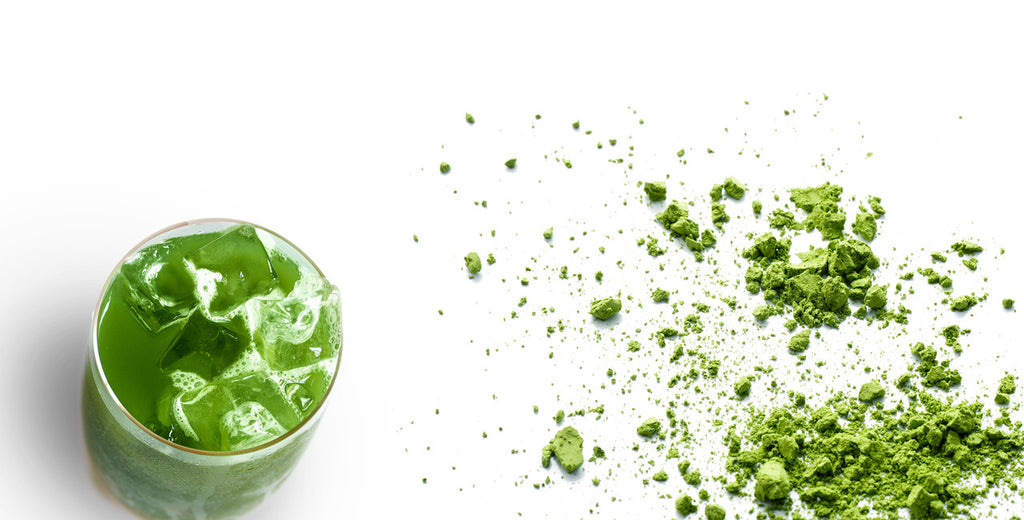
But first, what is matcha?
Matcha is pure green tea in powder form. Instead of steeping the leaves, you consume the whole leaf ground into a fine powder. You whisk the green tea powder in hot water to prepare it for drinking.
Just like regular green tea, Matcha is made from the leaves of the Camellia Sinensis plant, which is the tea plant we wrote about here. There are different varietals of the tea plant and three that grow the best leaves for matcha production: samidori, okumidori and yabukita. The plants are shade grown for 4-6 weeks before harvest. After plucking, the leaves are lightly steamed then dried. The stem and veins are removed and the leaves are ground into a fine powder, which is matcha.
What Makes Matcha So Special?
Matcha has so many unique qualities that sometimes it’s hard to believe that it comes from the same plant as oolong and black tea. One is not ‘better’ than another and comparing tea types in that way will keep you closed off from a whole world of exciting tea. Keeping that in mind, let’s explore what makes matcha unique and special.
Shade growing
There’s nothing quite like seeing in person how matcha is made, but we’ll do our best here to describe the process. Each year, between 4 and 6 weeks before harvest, the tea plants destined to become matcha are covered from direct sunlight. A traditional covering called Tana covers the plants with woven straw mats or a modern style covers them with black vinyl sheets a few feet above the tea plants. These mat covers are added by hand one layer at a time each week with subsequent layers being placed on top of the previous ones. This is a slow and gradual process decreasing the amount of light until about 90% of the light is blocked.


Above: Traditional Covering for shade-grown matcha
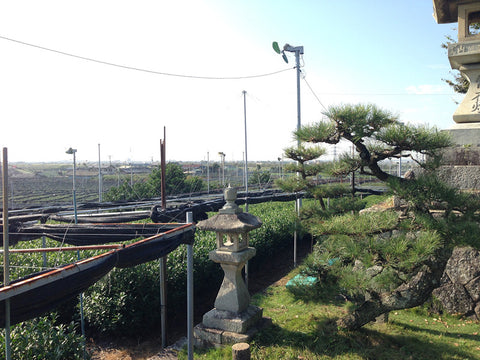
Above: Modern style covering for shade-growing matcha
The sun deprived plants then increase their production of chlorophyll to assist in photosynthesis due to the lack of sunlight entering the tea field. The boost in chlorophyll is what gives the leaves the vibrant jade green colour for premium matcha. Another effect of shade growing is the amino acids in the leaves aren’t broken down from direct sunlight, so the final powder has a more natural sweetness in flavour and aroma with little to no bitterness. One key amino acid that is preserved is L-Theanine. L-Theanine is responsible for helping in cognitive function, increasing the mind’s ability to focus. Its effects are similar to adaptogens, aiding in the regulation of stress.
Unique Method of Production
When the leaves are ready to be harvested, only the finest tea buds are picked - usually the youngest and greenest small top leaves. Once harvesting is complete the leaves are immediately taken to be steamed, preventing any oxidation to occur. After the steaming process the leaves need to be dried. Drying the leaves can be done by air-drying in a vertical wind tunnel.
Next, the leaves need to be destemmed and deveined. This is done mainly by air and an electrostatic process. Veins and stems are heavier than the leaf, making it easy for the meat of the leaf will be separated out. This meat of the leaf is called Tencha. Tencha is almost exclusively used for matcha production. Tencha is now ready to be processed into smaller pieces in preparation for the final stage, grinding.
The tencha leaves are ground into a micro-fine powder. Grinding is done in a temperature and humidity controlled room. The finest grinding stones called Ishiusu are hand-carved and have been used in matcha production for centuries.
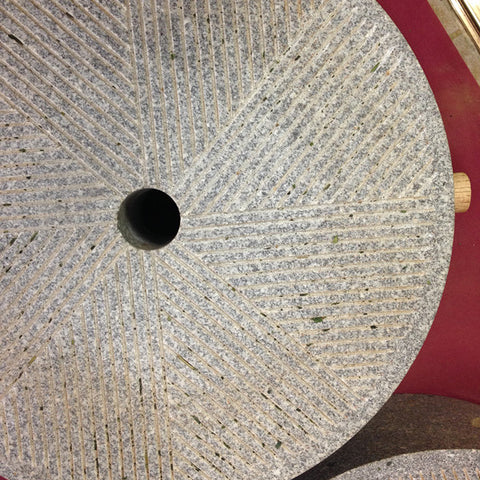
The grinding process is slow and takes up to an hour to produce 30 grams of matcha!
Taste the Umami
Umami .... a fifth taste that can be described as a rich, round and savoury flavour. It indicates the presence of the amino acids theanine and glutamate.[1] Matcha is high in umami flavour because shade growing provides protection from the sun and the breaking down of the amino acids. Matcha has a unique taste that lingers in a balance between naturally sweet, slightly bitter and grassy vegetal.
Unique and Impressive Health Benefits
- Matcha is rich in chlorophyll, which is where its vibrant green colour comes from. Chlorophyll is the green pigment found in the leaves and stems of plants. It is what absorbs energy from the sun to facilitate photosynthesis in plants. There are several different functions Chlorophyll has in the body: it detoxifies, it alkalizes, oxygenates and can even help with bad breath and body odour.
- Matcha green tea produces a significant increase in energy expenditure (a measure of metabolism) and has a significant effect on fat oxidation. Studies have found that consuming matcha green tea can increase thermogenesis, which is the body’s own rate of burning calories, from a normal 8-10 percent of daily expenditure to between 35 and 43 percent! And, it can improve physical endurance by 24 percent!
- On the ORAC scale (an antioxidant scale), matcha tops out at 1573 units per gram. To put that in perspective:
- the popular gojiberry has 253 units per gram
- blueberries have 93 units per gram
- spinach has 12.6 units per gram
- What does this all mean to you? Antioxidants are the body’s defence against free radicals from everyday exposure to things like pollution and UV radiation. Antioxidants are the chemical compounds that prevent ageing and chronic disease giving us younger looking skin and preventing a number of life-threatening diseases. They also play an important role in maintaining a healthy immune system.
- L-Theanine is a unique amino acid found almost exclusively in the tea plant and is the primary amino acid component of green tea. L-theanine stimulates the production of alpha waves in the brain. Alpha waves provide us with an incredible ability to focus and concentrate while maintaining a calm alertness. If this wasn’t amazing enough, L-theanine is clinically shown to reduces stress levels, blood pressure and PMS symptoms as well as improve cognitive abilities - boosting memory and learning.
- With matcha you won’t feel that “wired” sensation or experience a caffeine crash like you would with coffee, instead caffeine is slowly released over time. What's happening is the caffeine binds to catechins (antioxidants) and is released into the bloodstream slower because the catechins break down resulting in the release of caffeine over 3-5 hours. This prevents insulin and adrenaline spikes from happening in the body.
How to Choose Matcha
Look
Colour:
Bright green! Vibrancy is key. If a matcha is dull, yellow-ish, brown-ish or anything but pure green, it is either old or poor quality. It’s not always possible to see the matcha before you buy it, but at least you’ll know for next time if you buy one that’s not too green. Sometimes you'll buy a vibrant green matcha that's quite bitter, so don't be turned off matcha if that occurs, just try again with a different brand or higher grade matcha. Trust us, it's worth the effort!

Price:
Another good indicator of quality is price. A 30g tin of matcha should set you back $27-32 and good quality latte matcha should be in the range of $24-30. Same as the greenness rule above, there are exceptions with price because there are many companies out there hawking poor matcha for top dollar. That’s why it’s important to use a combination of these to choose your matcha.
Packaging:
Matcha is sensitive to light, so stay far far away from matcha packaged in clear pouches, jars or clear top tins.
ASK
Where does your matcha come from? If you’re shopping for a ceremonial grade matcha for sipping straight, and they say anything other than Uji or Nishio, Japan, you’re likely buying ingredient matcha that is best for lattes, smoothies and the like.
What harvest is your matcha made from? First harvest is the answer you’re looking for, especially if you want You can find latte-grade matcha that is first harvest, but you’re fine going with a second harvest.
How is the matcha ground? The best matcha is stone ground. You want to be careful with matcha that is pulverized by ball mills. This method creates heat, which kills nutrients.
How to Make Matcha at Home
Not sure how to prepare matcha at home? It’s actually really easy. Our recommendation is to pick up an electric milk frother. Then all you need to do is add a ½ teaspoon of matcha to the bottom of your mug. Add 2 oz of hot water and whisk with your electric frother for 20 seconds. Learn more ways to prepare it here.
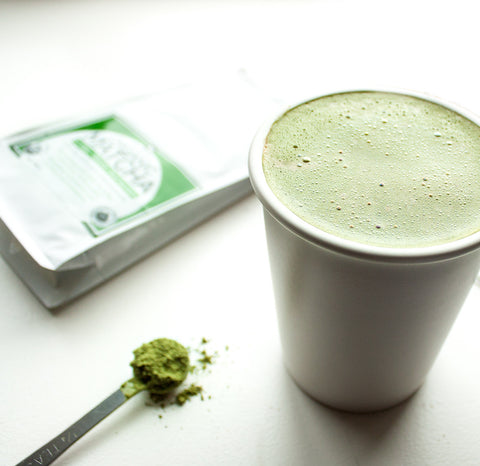
8 Ways to Drink Matcha
- Straight up! Whisk premium grade matcha with hot water only. You can also simply shake your matcha vigorously with cold water and ice for a refreshing summer drink.
- With Lemon. Make a ceremonial matcha, fill your mug with hot water and float a thin slice of lemon on the top. Lemon and matcha :)
- Ceremoniously! Set aside your work and make space physically and mentally to prepare your matcha. Use the traditional bamboo whisk (chasen) and matcha bowl (chasan) and whisk your matcha in a purposeful W shape. Slow your whisk down and remove your whisk while you draw a circle in the foam. Give a slight bow as you hold the matcha before taking your first sip.

-
As a latte. Whisk latte-grade matcha with a little hot water, then top it up with hot or cold almond milk. Add maple syrup to sweeten.
- In a smoothie. Add a teaspoon of latte/smoothie grade matcha to any smoothie. If you want to taste the matcha flavours, stick to frozen bananas, pineapple and honeydew.
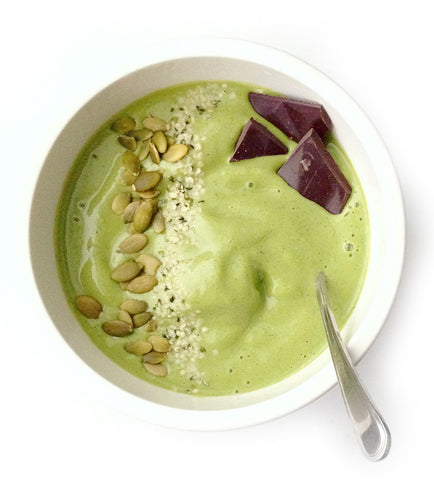
- As a pre-workout energy shot. Whisk your matcha with 1-2oz of hot water. Add a bit of cold water and shoot it back 20 minutes before a workout.
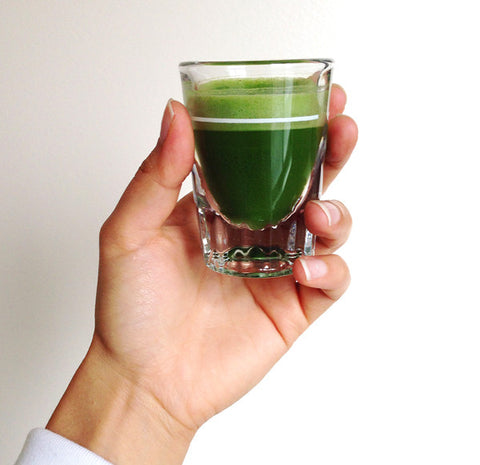
- Shaken with juice. Use fresh pressed juice if you can and simply shake with a teaspoon of latte-grade matcha. The best method is to shake with just a small amount of juice first. This will get rid of the clumps. Then pour in the rest of your juice.
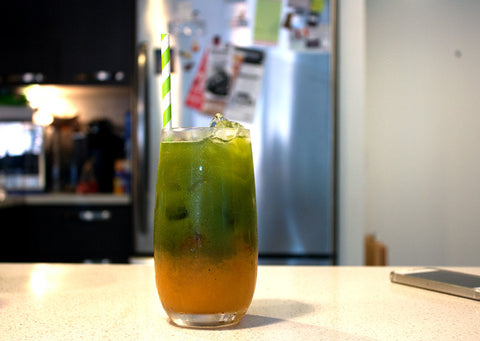
- Shaken with lemonade. Seriously if you haven’t tried this, you are missing out. By adding matcha, you don’t need to sweeten your lemonade so much. Make it from scratch or pick up an organic lemonade from the store.
Troubleshooting Your Matcha
You get all the hype, you’ve got yourself some matcha and you’ve made yourself a cup.... and it’s awful. Before you give it away to your friend on April Fool’s Day, let’s go through the most common mistakes.
> Your matcha tastes bitter. You might have bought a low grade matcha that isn’t meant for sipping straight with water. Is the colour dull or brown-ish? It’s low quality. If you’ve bought a premium matcha and it still tastes bitter, you may have added water that is too hot. Let it cool to 70°C- 80°C (160°F-175°F) before adding it to the matcha powder.
> You’re drinking clumps of powder. Use an electric milk frother/hand frother or a bamboo whisk and whisk for 20 seconds. If you’re already whisking and there’s still clumps, try sifting your matcha first through a sieve, tea ball, tea filter or matcha sifter. Maybe you’re whisking with too much water! Use just a small amount, an ounce or two, when whisking. Top up your cup with more water after you’re done whisking.
> There’s no foam. There’s a few possible reasons for this one. Your matcha may be low quality, your water may not be hot enough, you’re not whisking very well or you’re not sifting your matcha first.
> Your matcha isn’t dissolving. Matcha actually doesn’t dissolve. When you whisk, the matcha powder is suspended in the water. If you sip your matcha leisurely, you may need to stir it up as you sip.
> You feel like a crazy person after drinking matcha. You’ve added too much matcha! Matcha still has caffeine. Yes, it has 1/3 less than a cup of coffee, but if you’ve recently had a coffee or a few cups of black tea and then you have your matcha that caffeine adds up! If you’re sensitive to caffeine, start with a ¼ teaspoon of matcha and work your way up.
What other problems are you encountering with your matcha? Let us know in the comments and we’ll help you troubleshoot your matcha!
Don't want to worry about all these decision factors? Try our matcha! We have organic ceremonial grade, latte grade and matcha superfood blends. You can check them out here.
We learned a lot of this information while studying matcha and travelling in Japan. A couple other sources for this article include:
Umami Information Centre http://www.umamiinfo.com/richfood/foodstuff/greentea.php
Beneficial effects of green tea: A literature review, https://www.ncbi.nlm.nih.gov/pmc/articles/PMC2855614/
